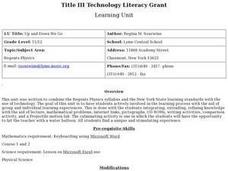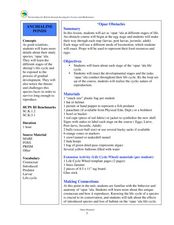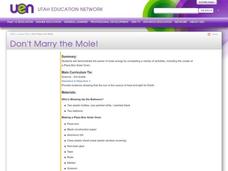Curated OER
Sound Waves
Sixth graders discover how sound is made from vibration and moves in all directions from the source in waves. They see that sound waves can be "seen" if they are translated into light. An excellent experiment is imbedded in this...
Curated OER
Up and Down We Go
Learners explore physics concepts such as velocity, acceleration and speed to create a model of a safe roller coaster. They design and conduct a lab to demonstrate the properties of an object fired horizontally and at an angle.
Curated OER
Let's Think About... Magnets and Gravity
Students watch an episode of the PBS show "Jay Jay the Jet Plane," and explore magnets and gravity. They conduct various experiments involving magnets and sand, bean bags, and a fishing pole with magnets.
Curated OER
Properties of Air
Pupils conduct investigations to demonstrate and learn that air takes up space, and puts pressure, or pushes, on everything around it. They conduct experiments to learn about feeling air pressure and measuring air pressure. Prior to...
Curated OER
Basic Needs of Living Things-Lesson One
Fourth graders explore the basic needs of living things. They observe a variety of living things and identify the basic needs of each living item. Students create food balls of peanut butter and nuts to feed animals. They hang their food...
Curated OER
Plop! Plop! Fizz! Fizz!
Fourth graders study physical and chemical weathering. They explain how the processes of weathering and erosion change and move materials that become soil. They create a K-W-L chart to show what they know and list what else they would...
Curated OER
Water and Ice
Students observe water as it changes form. For this water lesson students observe, measure, and describe water as it changes state.
Curated OER
Winter and Summer Storms Scenarios
Fourth graders analyze how summer and winter storms are different. In this weather lesson, 4th graders construct a winter storm simulation box and a summer storm bottle and record the temperature and barometer readings. The directions to...
Curated OER
Take Two and Call Me in the Morning
Eighth graders are introduced to the workings of the major systems of the Human Body: circulatory, digestive, respiratory, nervous, skeletal, and endocrine Systems. They learn the major organs of the systems and their functions.
Curated OER
Cling On's
Students define the term static electricity and how to it. In this electricity lesson students design and implement an experiment to show how static electricity affects their daily lives.
Curated OER
Guess What?!
Students explore how scientists work. In this scientific method lesson, students use their senses to identify objects they cannot see. Students are asked to think like scientists and make observations, comparisons, and interferences, as...
Curated OER
Treacherous Trash
Students recognize the harmful effects people have on the environment. In this environmental lesson, students simulate water pollution clean-up by using tangled objects and untangling them in a cooperative group. Students identify why...
Curated OER
Sunlight and Warm Air
Students discuss radiant energy from the sun, performing a simple experiment with sun glasses and bright light to demonstrate the concept. Students further participate in simple in-class experiments to demonstrate: air density as it...
Curated OER
Gravity and Layers of Air
Students actively look and listen as their teacher provides transparencies to show how the atmosphere is made up of layers. In this atmosphere lesson plan, students discuss the atmosphere in terms of layers and how gravity pulls...
Curated OER
Density
Young scholars explore the meaning of density. In this density lesson, students use interactive whiteboards to review definitions regarding density and compare the density of selected objects.
Curated OER
Rising Air
Students investigate the concept of rising air in the formation of clouds and precipitation. In this rising air instructional activity, students conduct an experiment with hot and cold water that shows how warm water rises due to thermal...
Curated OER
Make a thermometer
In this thermometer instructional activity, students make a thermometer out of a straw, juice bottle, food coloring and more. Students also answer 3 questions about it.
Curated OER
Yeast Cells and their Environment
Pupils study the scientific method and explore how to design an experiment. In this investigative lesson students explore and hypothesis an experiment then carry it out to find the results.
Curated OER
Breaking News: Virgin Voyage to the Bottom of the Ocean (7th April, 2011)
Students explore current events by reading about a trip to the bottom of the ocean. In this modern day explorer instructional activity, students read about Virgin CEO Richard Branson and his adventure to the bottom of the ocean. Students...
Curated OER
10 Great Places to Savor the Wild Blue Yonder
Students discuss developments in aviation. In this reading comprehension lesson, students read an article that discusses ten aviation museums and developments in civil and military aviation. Students find relationships...
Curated OER
Opae Obstacles
Students explore the life cycle of shrimp. In this life cycle lesson, students research the different stages of a shrimp's life cycle. Students examine threats to the species in each stage of life.
Curated OER
As a Matter of Fact
Students rotate through various hands-on experiment stations to explore the concept and properties of different types of matter. They compare some properties of solids, liquids and gases and describe how matter changes from one state to...
Curated OER
Don't Marry the Mole!
Third graders demonstrate the power of solar energy by completing a variety of activities, including the creation of a Pizza Box Solar Oven.
Curated OER
Learning Planet Sizes
Students utilize the concepts of greater than, less than, and equal to, in order to classify student height, object size, and planet size. They build scale models of the planets based on their discoveries of planet size.























